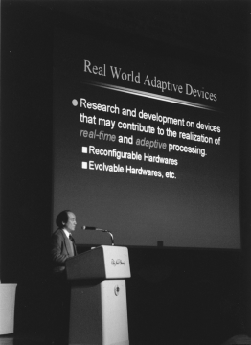
| Nobuyuki Otsu Director Machine Understanding Division Electrotechnical Laboratory |

| Nobuyuki Otsu Director Machine Understanding Division Electrotechnical Laboratory |
I would like to briefly explain Real World Intelligence Technology. First, I'll begin with its background (Fig. 1).
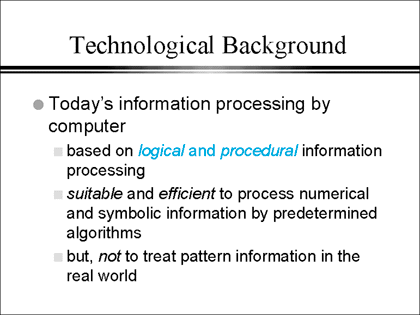
Fig. 1
Today's information processing technologies are, as you see, based on a computer's logical and procedural information processing. It is a very efficient method for processing numerical or symbolic information along a prepared program or algorithm in this sense, but not necessarily suitable for handling pattern information in the real world.
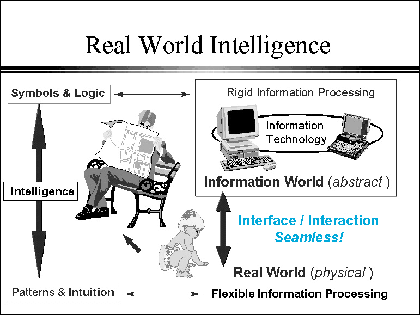
Fig. 2
This figure shows the concept behind real world intelligence (Fig. 2). We form our intelligence through interactions with the real world. First, we only play with the real world, but then gradually our intelligence forms. Intelligence has many levels. One, for example, may be focused on patterns and intuition and another focused on symbols and logic at a higher level. Current computer technology realizes information processing focused on symbols and logic. In this sense, computers perform very rigid information processing.
On the other hand, the information processing we do naturally in the real world is very flexible.
The problem here is that there is a very big gap between the symbolic world (i.e., the current information world) and the real world. I think the biggest technical challenge to today's information processing is to fill this gap. That is, to make interfaces or interactions more seamless.
This figure shows information processing technology from the past to the future (Fig. 3).
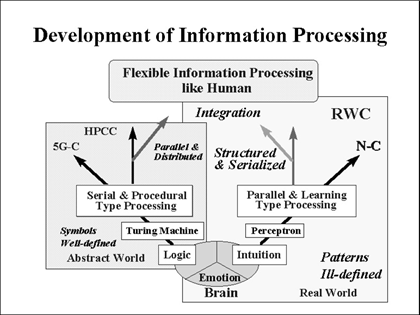
Fig. 3
As you can see, today's information processing technology uses the Turing Machine as a model, and advances the logical side of the brain, as sequential and procedural information processing. The Fifth Generation Computer (5G-C) Project further advanced the logical side. The High Performance Computing and Communication Initiative (HPCC) is a policy oriented toward parallel, distributed, and high-speed processing. These fields are very efficient in handling well-defined problems. That is, handling an abstract (information) world.
However, our brain has another side. It is an intuition side, simply performing parallel and learning-type information processing as the neural network performs using perceptron as a model. The extremity of this is the neural computing (N-C). The Real World Intelligence Technology, formerly called RWC, as shown in this old transparency, has a goal of flexible information processing to further advance in these directions.
This figure is entitled┼gCommunication of Humans and Computers┼h(Fig. 4).

Fig. 4
Humans develop their intelligence through interactions with the real world. Interactions in this case are those mainly via pattern information such as spatial images or temporal voices. Through those, humans can also form high-level intelligence in the symbol world. Likewise, computers operate very efficiently in the symbol world. However, they are weak at interactions with the real world, because they have few channels. Communication between humans and computers so far has been done through a narrow channel in the symbolic world; through keyboards, which constitutes a bottleneck. In the future, we need to enrich interactions between computers and humans, and for this we need to expand communication channels. To do this, we need to form channels so that computers can understand pattern information directly just as humans do daily, and for this we need to implement the real-world intelligence into computer's interaction channels with humans.
Considering information processing in the real world (Fig. 5), much of its information is pattern information.
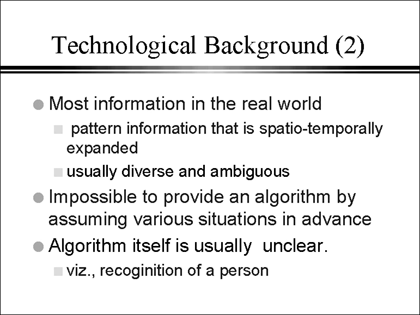
Fig. 5
This pattern information expands spatio-temporally - and is usually very diverse, ambiguous, and incomplete. We can only obtain bits of information at a time, and in this sense only partial information is available. It is usually very difficult to write programs taking every case into account, and the algorithm itself is quite unclear. For instance, we recognize other people unconsciously but we don't know what algorithm is used.
The human brain has developed an information integration and learning type of information processing (Fig. 6). It may be considered that the brain has developed this type of information processing to effectively deal with pattern information in the real world. Symbolic intelligence is actually formed on this basis. Learning and self-organizing functions provide humans with the ability to be adaptive to diverse environments or changes in the situation of the real world. How is it done? By changing the connection of neural networks according to experiences, the brain gets wiser and wiser in such a sense.
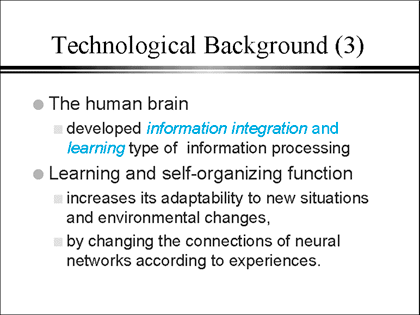
Fig. 6
Therefore, the most important need in information processing technology today is to implement functions like such real-world intelligence into current information processing systems (Fig. 7).
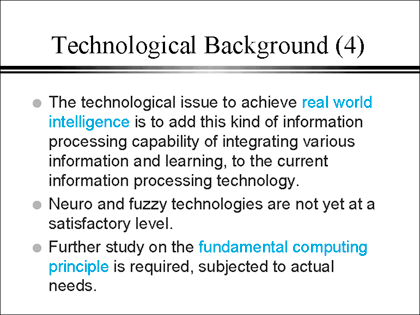
Fig. 7
Although some neural or fuzzy technologies have been developed, they are still insufficient. Therefore, it is very important for us to continue owr studies on more advanced and more basic principles of computation. At the same time, we need to integrate these studies by matching them with actual needs.
Thus, the objectives of this field are to develop fundamental technologies. That is, we must develop fundamental technologies for adding the real-world intelligence to conventional information processing systems, and to expand the application fields of information processing (Fig. 8).
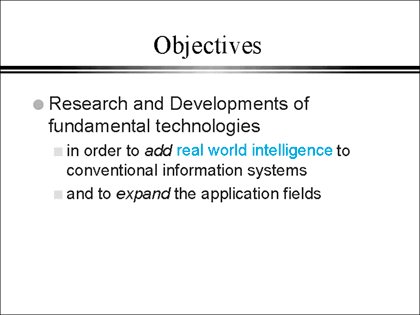
Fig. 8

Fig. 9
This figure shows these goals (Fig. 9). The Fifth Generation Computing added a method of handling symbols and logic to conventional computing. Real World Computing aims to add intelligence, flexible enough to deal with diverse information, in the real world.┼gComputers should come close to humans,┼hrather than┼ghumans should come close to computers,┼has is conventionally put.
For this, we need to promote research and development of the following elementary or basic functions (Fig. 10).
One is a technology for integrating information. This is a technology for comprehensively judging or recognizing diverse information in the real world, or a technology for utilizing such information for decision making in a subsequent or future action.
The other is a technology for learning and self-organization. This function allows systems to acquire information autonomously through interactions with the real world and to make their functions adaptive or evolving. These two are the most basic functions for realizing real world intelligence.
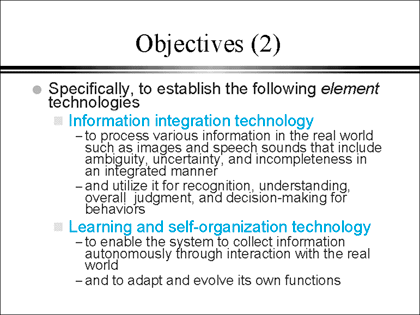
Fig. 10
With these foundations, we would like to realize information integration and learning-type information processing, rather than just continue with conventional information processing of procedural type (Fig. 11). In other words, we would like to build systems which can handle diverse information in the real world in its original form, and can understand or predict the environment, or respond autonomously.
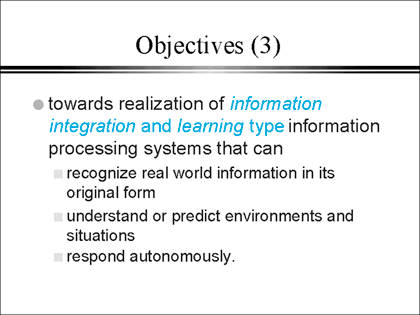
Fig. 11
For these objectives, we have established five core areas for research and development (Fig. 12). To carry on research on fundamental technologies, we need to narrow down problems by assuming prototype systems. Therefore, we will concentrate on three system areas. I believe that these constitute the minimum effort necessary to cover basic information processing abilities which are the ability to recognize, understand, reason, or control.
The multimodal system, the autonomous learning system, and the self-organizing information base system can be translated into a human interface, an autonomous robot, and a new type of information base, respectively.
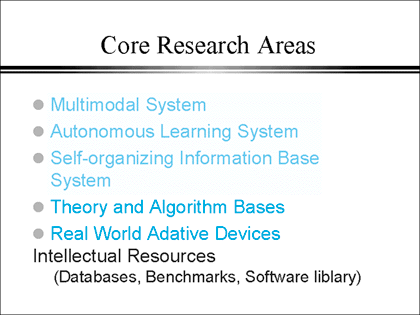
Fig. 12
We can think of two fundamental technologies to support these efforts. The most important are theory and algorithm bases. By studying these areas, we can support the above three systems. We consider the theoretical basis of great importance in bringing about a true breakthrough, thus preventing the end result of these technologies from becoming a simple collection of heuristics. We believe that a truly new technology will be created through this interaction.
In addition, we need a hardware basis. This does not mean we need supercomputers, but we may need certain specialized devices for applying such systems to the real world, in real time. They are tentatively called Real World Adaptive Devices, and we will develop them as we go along.
To accelerate or evaluate such research and development, it will be very important to establish and enhance┼gintellectual resources.┼hWe need to establish various databases, to evaluate the techniques developed by taking into account benchmark challenges, and to establish and enhance newly-acquired techniques neatly as software libraries.
Next, I would like to consider each core unit independently (Fig. 13).
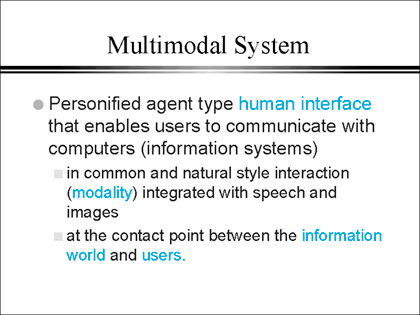
Fig. 13
The multimodal system can be likened to a personified agent system. This aims at making interactions between humans and computers smooth, and┼gsmooth┼hin this context means using communication channels that we, the users, use daily. Common and natural interactions would be interactions with computers using modality. Specifically, these interactions include processing of speech and images such as gestures or hand movements. This technology is at the contact point between the information world and the users.
Next, I will explain an autonomous learning system (Fig. 14).
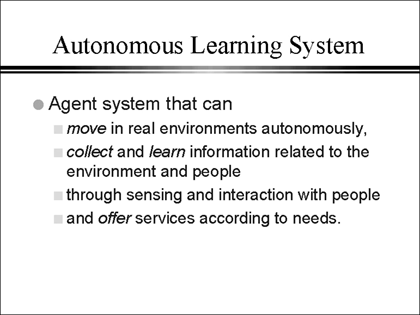
Fig. 14
The autonomous learning system can be considered an agent which moves around in the real world autonomously. It is a system which is mobile in the real world and collects and learns information on diverse environments, or information on people. It is in a sense considered a testbed for integrating novel functions. It is a system which acquires and learns information to grow wiser though various kinds of sensing of environments or through interactions with associated humans. Finally it will grow into a system which can offer services according to various needs.
Next, I would like to explain a self-organizing information base system (Fig. 15).
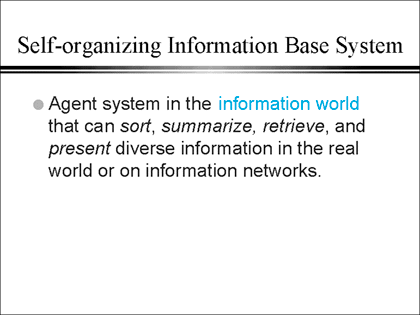
Fig. 15
This system can be considered an agent system in the information world. It is a technology for sorting, summarizing, retrieving, or presenting a vast amount of information in the real world or on a network easily to understand. We believe that this technology is urgently required in the current information society, especially in the age where floods of information typically encountered on the Internet. The goal should be a system which can flexibly process information using the new techniques of real world intelligence, rather than with conventional procedural methods.
Next I will explain the fundamental technologies supporting those systems. First, I will touch on the theory and algorithm bases (Fig. 16).

Fig. 16
We study common algorithms, or a more genuine theory, to support a system which integrates the functions just explained. For instance, we will study theories on information integration, theories on learning and self-organization, and various optimization techniques.
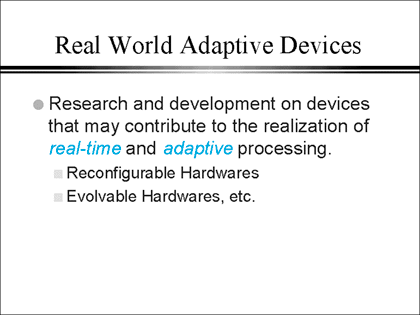
Fig. 17
Real world adaptive devices (Fig. 17). Systems in the real world are, in a sense, required to operate at a very high speed, hopefully at real time. It is desirable to achieve these standards through the application of software, but it is usually difficult to do so. Thus, hardware support will be essential, furthermore, learning and self-organization may be better accomplished at the hardware level. The devices considered here are a new type of reconfigurable, or self-evolvable hardware.
Finally, the intellectual resources for such research (Fig. 18) may involve all of the aspects I have covered. For instance, it is important to establish real world databases of speech and images while designing and evaluating the real world intelligence systems. In addition, we need to set up benchmark test items in order to compare various techniques and to establish a merkmal of the research. It is also important to archive these results in libraries so that acquired techniques will not disappear at a ad hoc level. Such libraries are important because they can accelerate the research and leave research results in a stable form for coming generations.
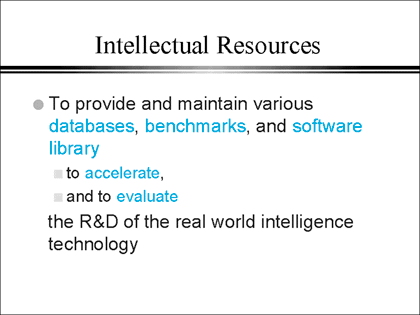
Fig. 18
So far I have explained our current research activities. Now, I would like to proceed to explain how the above research and development will be carried out (Fig. 19).
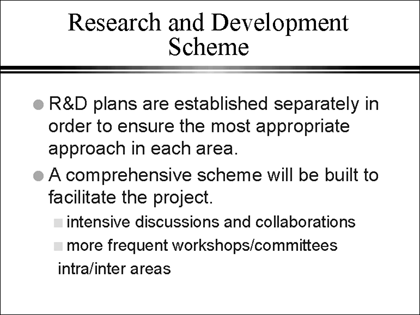
Fig. 19
Currently, we are developing a basic research plan by taking into account the style needed to facilitate research in each area. To actually promote our plans, we need to stimulate deep discussion in each area, give directions, and encourage cooperative research. To do so, I think we need to hold workshops and committee meetings more frequently within each area and across areas.
Since I have some time to spare, I would like to express my personal view in detail (Fig. 20).
Procedural processing in conventional information processing is a linear model (M1) whereby we convert input information into output information as an algorithm. This is a direct method often with a rigid framework.
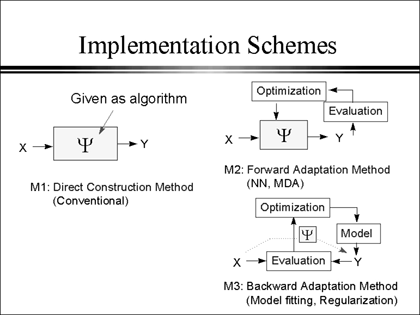
Fig. 20
In contrast, a neural network or multivariate data analysis is a method based on a feedback loop for optimization with evaluation by including degrees of freedom as parameters in the processing. With this, it learns the optimal processing from examples. It is, in a sense, a forward adaptation method (M2).
Model fitting or regularization theory may be considered a backward adaptation method. It evaluates the difference between input information and proper output information assumed as a model to update itself. With this, it attempts to obtain optimal, though implicit, processing (M3). I think as we consider real-world intelligence, we must take such new techniques into account.
I often express the dialectic development stages of artificial intelligence as┼gABC┼h(Fig. 21).┼gA┼hrefers to research on conventional Artificial intelligence in a narrow sense which is too artificial. This is a framework for intelligence focused on such deductive logic as symbol processing, knowledge processing, knowledge representation, and production rules.
However, today's boom in neural network research is related to Biological intelligence. This aims at sub-symbolic computation. Thus, the focus has shifted a little bit more towards inductive logic.

Fig. 21
However, I think it is necessary to strengthen this project towards by confirming the unified principle of computation behind these stories and deepening them theoretically. This includes stochastic computation, Bayesian network, etc. I think in its base lies a framework for Bayesian logic and inference, initially called soft logic, or decision making.
I also think that it is necessary to take a look at the pattern recognition again to deal with pattern information in the real world (Fig. 22).
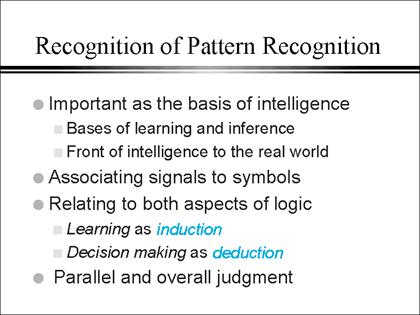
Fig. 22
Pattern recognition is very important as the basis for intelligence. It is the basis for learning and inference. It is the gateway to intelligence in the real world. Pattern recognition bridges patterns and symbols. From a logical perspective, pattern recognition has an inductive learning phase and deductive decision making phase. In addition, pattern recognition essentially focuses on parallel processing or overall judgment.
I think that behind flexible information processing, in areas such as pattern recognition, neural computation, regularization, or stochastic inference, lies a Bayesian framework (Fig. 23). Multivariate analysis represents such things most simply as a linear model, and what allows for non-linear functionality to some extent is a neural network. In its extremity lies the Bayesian estimation.
This concludes my speech.
Thank you very much.
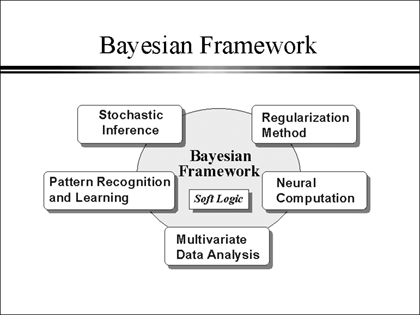
Fig. 23
